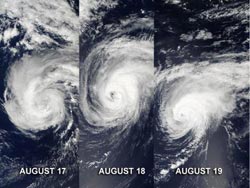NASA satellites capture 3 days of Hurricane Gordon's Atlantic track

These three images from the MODIS instrument on NASA's Terra and Aqua satellites were captured on Aug. 17-19 and show the progression of Hurricane Gordon through the eastern Atlantic Ocean.<br><br>Credit: NASA Goddard MODIS Rapid Response Team<br>
The Moderate Resolution Imaging Spectroradiometer, or MODIS, is an instrument that flies onboard NASA's Terra and Aqua satellites and provides high-resolution imagery to users. When NASA's Terra satellite flew over Gordon on August 17 at 9:30 a.m. EDT it was a tropical storm and did not have a visible eye.
It was followed up by a fly over of NASA's Aqua satellite on August 18 at 11:50 a.m. EDT, it had strengthened into a hurricane and had a clear and visible eye. On August 19, Gordon was still a hurricane at 10:55 a.m. EDT when NASA's Aqua satellite again passed over the storm. At that time, Gordon was affecting the Azores Islands. Ocean swells in the eastern Azores generated by Gordon are expected to start subsiding today, August 20, as Gordon moves east and toward Portugal.
At 8 a.m. EDT (1200 UTC) on August 20, Gordon weakened back to tropical storm status with maximum sustained winds near 70 mph (110 kmh). The center of Tropical Storm Gordon was located about 115 miles (180 km) east-northeast of Santa Maria Island in the Azores, near latitude 37.7 north and longitude 23.2 west. The National Hurricane Center noted that Gordon is moving toward the east-northeast near 15 mph (24 kmh) and is expected to slow and turn east.
The National Hurricane Center expects Tropical Storm Gordon to become extra-tropical later in the day on August 20.
Media Contact
More Information:
http://www.nasa.govAll latest news from the category: Earth Sciences
Earth Sciences (also referred to as Geosciences), which deals with basic issues surrounding our planet, plays a vital role in the area of energy and raw materials supply.
Earth Sciences comprises subjects such as geology, geography, geological informatics, paleontology, mineralogy, petrography, crystallography, geophysics, geodesy, glaciology, cartography, photogrammetry, meteorology and seismology, early-warning systems, earthquake research and polar research.
Newest articles

Bringing bio-inspired robots to life
Nebraska researcher Eric Markvicka gets NSF CAREER Award to pursue manufacture of novel materials for soft robotics and stretchable electronics. Engineers are increasingly eager to develop robots that mimic the…

Bella moths use poison to attract mates
Scientists are closer to finding out how. Pyrrolizidine alkaloids are as bitter and toxic as they are hard to pronounce. They’re produced by several different types of plants and are…

AI tool creates ‘synthetic’ images of cells
…for enhanced microscopy analysis. Observing individual cells through microscopes can reveal a range of important cell biological phenomena that frequently play a role in human diseases, but the process of…





















